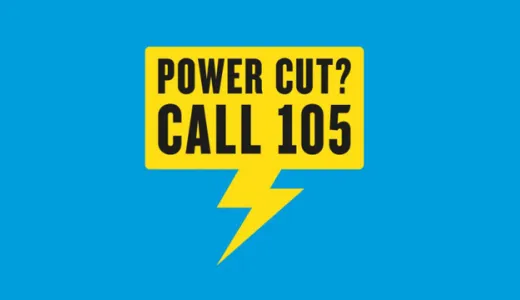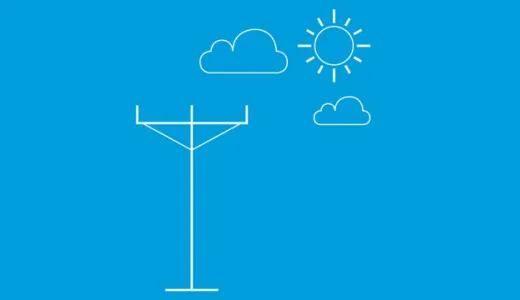Electricity transmission emergencies and safety advice
National Grid Electricity Transmission take electricity generated from windfarms and other power sources and transport it through our network of pylons, overhead lines, cables, and substations. It then goes on to separate lower voltage local distribution networks, which connect directly to homes and businesses.
On this page, you'll find out what you should do if you see a hazard or emergency involving high voltage transmission power lines or pylons.
To report a power cut or issue with the distribution network please call 105.

Transmission overhead line emergencies
The transmission network is like the motorways, carrying vehicles (electricity) at high speed (high voltage) across the country. This is the network of big pylons and overhead lines you see around the country.
The distribution networks are the local roads, connecting motorways with communities to help vehicles complete their journey. These are the wooden poles (and smaller pylons and underground cables) carrying lower voltage lines.
What to do in a transmission overhead line emergency
For domestic power cuts or concerns with distribution infrastructure (typically wooden poles) please contact 105.
If you spot a potential hazard on or near a transmission overhead electricity line (metal lattice towers) please call the 24-hour electricity emergency helpline 0800 40 40 90.
- Follow these steps:
- do not approach any hazard, even at ground level - keep as far away as possible
- warn anyone in the area to evacuate or stay away
- tell us where the emergency is. If you don't know you can describe the area or look for road signs
- explain what's happened and what you can see
- give your name and phone number.

Fire and rescue service advice
Download our Fire and Rescue Guidance document to find out more.
Safety advice and more information
Please click on the relevant topic below for more advice and information.
If any changes in ground levels that are proposed in the vicinity of the overhead line might reduce safety clearances, please contact us first.
Safety advice for overhead lines:
- never use the base of a pylon (tower) or area immediately around it to store materials
- take care where radio aerials are attached to high vehicles
- take care when moving or tensioning electric fences, particularly in sloping areas
- don’t stand under the base of pylons (towers) during electrical storms
- do not direct jets of water or slurry at overhead power lines
- do not excavate where it would disturb the pylon (tower) foundations.
It's dangerous to climb on top of high vehicles parked or passing under overhead electricity wires.
Avoid operating tall equipment or lifting gear beneath an overhead electricity line.
No plant, machinery, scaffolding, or personnel should encroach within the safety zone of overhead conductor lines.
Take care when moving ladders, elevators, irrigation pipes or other long objects. They should be moved only when horizontal or in their lowest position.
Never reduce the clearance under overhead electricity lines by dumping or tipping waste material, erecting structures, buildings or hay stacks, or creating storage areas under lines.
No plant, machinery, scaffolding, or personnel should encroach within the safety zone of the overhead conductor lines.
Take care when moving ladders, elevators, irrigation pipes or other long objects. They should be moved only when horizontal or in their lowest position.
Never reduce the clearance under overhead electricity lines by dumping or tipping waste material. erecting structures, buildings or hay stacks, or creating storage areas under lines.
Flashovers
Overhead electricity lines are normally bare (uninsulated) and if an object gets too close it is possible that a ‘flashover’ can occur, where electricity will jump over a distance to reach earth via the object. Flashovers can kill or cause severe shocks and burns to any person nearby.
In order to prevent flashover there are minimum safety clearances between overhead lines and the ground, roads, or objects on which a person can stand.
A flashover to a tree can cause a loss of supply to customers, a fire in the tree, or can lead to the tree itself conducting electricity.
Despite the dangers, we cannot actually prevent trees and vegetation being planted beneath our overhead electricity lines, as we do not own the land.
We have a duty to make sure that no tree comes close enough to an overhead electricity line to cause a flashover.
We employ specialist contractors to undertake vegetation management beneath our overhead electricity lines to make sure safety clearances are not infringed over a number of growing seasons.
All vegetation clearance work beneath and adjacent to overhead electricity lines must be carried out by specially trained staff.
Planting trees near overhead power lines or pylons
Only low height, slow growing species should be planted beneath overhead electricity lines, conductors, and towers.
If you are proposing planting in the area around a pylon (tower) base, you should consider the need to maintain safe vehicle access to the tower base for overhead line maintenance activities, and to prevent unauthorised access to towers.
Tree roots can disturb and prevent access to maintain underground electricity cables. Our prescribed planting distances between trees and buried services must be observed.
Please contact us for detailed technical advice before you finalise any landscape scheme.
Safety advice for leisure activities near overhead lines:
- never fly kites or model aircrafts near overhead power lines
- be careful to avoid lines when operating light aircrafts, hot air balloons, gliders etc
- fishing rods and poles made from carbon fibre and similar materials will conduct electricity. Fish at least 30 metres or more away from overhead lines
- do not light fires beneath overhead lines
- do not aim shotguns or pistols at overhead power lines.
Large birds, such as swans and geese, sometimes collide with overhead line conductors in poor visibility, resulting in their injury or death.
Where bird collision has been identified as a problem, sometimes line-marking devices can be fitted to increase a line’s visibility.
Overhead line towers are sometimes used by birds as convenient structures for roosting, often in significant numbers.
Where bird fouling is a problem a number of methods to dissuade birds from roosting on towers may be used. The effectiveness of the bird scaring is monitored in conjunction with grantors and wayleave officers.
High-voltage overhead lines and certain items of substation equipment can generate noise. With lines, the level of this noise depends on the voltage. Sometimes a ‘crackling’ sound accompanied by a low-frequency hum can be heard.
Noise from an overhead power line is produced by a phenomenon known as ‘corona discharge’. Overhead lines are built to minimise this, but surface irregularities caused by damage, insects, raindrops or pollution may locally enhance the electric field strength sufficient for corona discharges to occur.
The noise levels associated with an overhead power line are weather-related and higher noise levels are likely to occur during:
- damp weather conditions
- long dry spells, when airborne debris sticks to the lines (but this is washed away by a heavy rain shower).
Where complaints about noise arise, we will investigate the cause of the noise and, if our equipment or practices are at fault, do all that we reasonably can to minimise the noise level.
We also research lower noise alternatives that can be used when installing or refurbishing equipment. Where practical, we will deploy new techniques or equipment that produce less noise.
All our employees and contractors carry identification. Ask to see their identification if you are unsure about people visiting your land.
Don’t assume that delivery drivers and contractors know, or have remembered the route of, overhead electricity lines. Remind them – it could save their lives.

